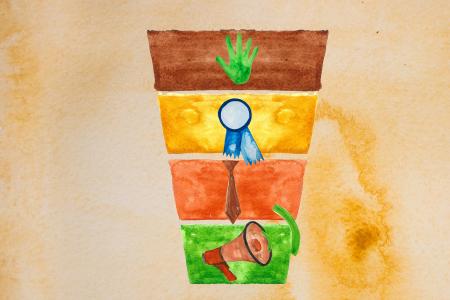
Have you ever had a super excited volunteer say they love your organization on their first day, and that they’ll be back for the next event, and then just disappear? Hey, I feel you. It’s happened to me, and I’ve been that person as well. Why does this happen? How can we prevent this from happening?
A lot of work goes into drumming up interest. However, if you can’t retain volunteers after one engagement, you, my friend, have a leaky bucket! And there’s no better way to fix leaky buckets than to plug the holes.
But before we go about playing plumber… let’s talk about how this bucket analogy works...
It's Not Just One Bucket
As you probably already know, we can’t expect new, first-time volunteers to suddenly become our dream team of die-hard, fully committed volunteers. It often takes time, nurturance, and thoughtfulness to help volunteers find the right place in your organization where they can thrive and stay committed to your organization’s mission.
With that said, volunteer retention is not just about one bucket’s leakiness. Instead, volunteer retention is more like a cascade of buckets that pour from one bucket to the next. This represents how a volunteer moves from one stage or commitment level within your organization to the next.
A Series of Buckets!
This bucket analogy is a principle used in marketing to get people to take action and purchase a product. It’s often called a funnel. A personal example with this blog: my hope is that if 100 people read this blog article, and 20 subscribe to the blog, and 5 people try out Track it Forward, maybe 1 person will use Track it Forward to track volunteer hours. At each stage or "bucket" along the way, if you are the right volunteer, my goal is to help you get from one stage to the next. So how does this relate to volunteer retention?
Apply the same principle to volunteer recruitment. If you get 100 volunteers to your big Earth day event, for example, and 20 of them sign up for the next event, and 5 of them become repeat volunteers, and 1 person eventually takes a leadership role, that’s a success! It’s impossible to have a perfect conversion from one bucket to the next, but at least the water is flowing. And now that you’ve got a clear progression of stages, you can start improving that conversion rate by reducing the leaks between them.
Label the Buckets
Give each "bucket" or stage/tier a name, or some type of label. In my current volunteer organization, we have 4 tiers of volunteers: Volunteers, Super Volunteers, Members, and Partners. Each tier should have a clear set of responsibilities and different perks/privileges that the other tiers do not. Reinforce the volunteers' connection to your cause as they advance up the tiers. If each stage gets them more committed, they should be closer to creating the connection they are looking for.
Give the Buckets an Order
You need to be clear about how to get from one stage to the next. For example, after each event, allow your volunteers to sign up then and there for the next event. After they’ve volunteered a certain number of times, let them know they can now volunteer at any time they want without supervision, or that they can start training new volunteers. Once they’re a consistent repeat volunteer, reach out to them and talk about them becoming a leader in the organization. The key here is that you are reaching out to them and helping them move up the ranks at certain thresholds.
Perks and Privileges
Volunteers are devoting their time and energy into your organization, and the organization should show appreciation by giving back to them, too. I know, I know, volunteers are volunteering because they love it. I agree, that’s why I volunteer, too! But providing incentives is a psychological acknowledgement that the organization values their commitment, and it reinforces advancement within the organization.
In my social-dance organization, we are contemplating these perks and privileges:
Volunteer:
For every 30 minutes of volunteering, they get a stamp on their volunteer card which they can redeem for free dance classes
Invitation to the annual volunteer appreciation party
Super Volunteer:
Free access to all social dancing, classes, and practice sessions
Invitation to attend meetings
Members:
Monetary stipend to use on other dance classes and workshops in the area
Invitation to partner-level meetings
Partner:
Larger monetary stipend to use on dance classes, workshops, and leadership development
Advocating to be on guest lists of all other local dance venues
Since my dance organization has a budget and a physical product, we can offer more tangible monetary or product incentives. However, since many nonprofits don't have products or monetary incentives to give their volunteers, they can still offer intangible incentives such as access to interesting events, volunteer appreciation parties, or volunteer awards ceremonies.
How do you get started?
Literally just write down your different "buckets" or stages, and make sure they have one of the following:
A label
A trigger identifying when to reach out to the volunteer
An action by an organizer to advance them from one stage to the next
A set of responsibilities / privileges different from the previous stage
Many organizations just assume a volunteer will just stick around and advance themselves. But if you don’t show them the way, they tend to lose steam. If you nurture your volunteers and help them walk down the path they are excited to be on, not only will they stick with you but they can help you reinforce this process for others.
I’m really curious about the type of stages you have at your organizations. How do you classify your different levels of volunteers? Just add them to the comments below!
 Written by
Written by